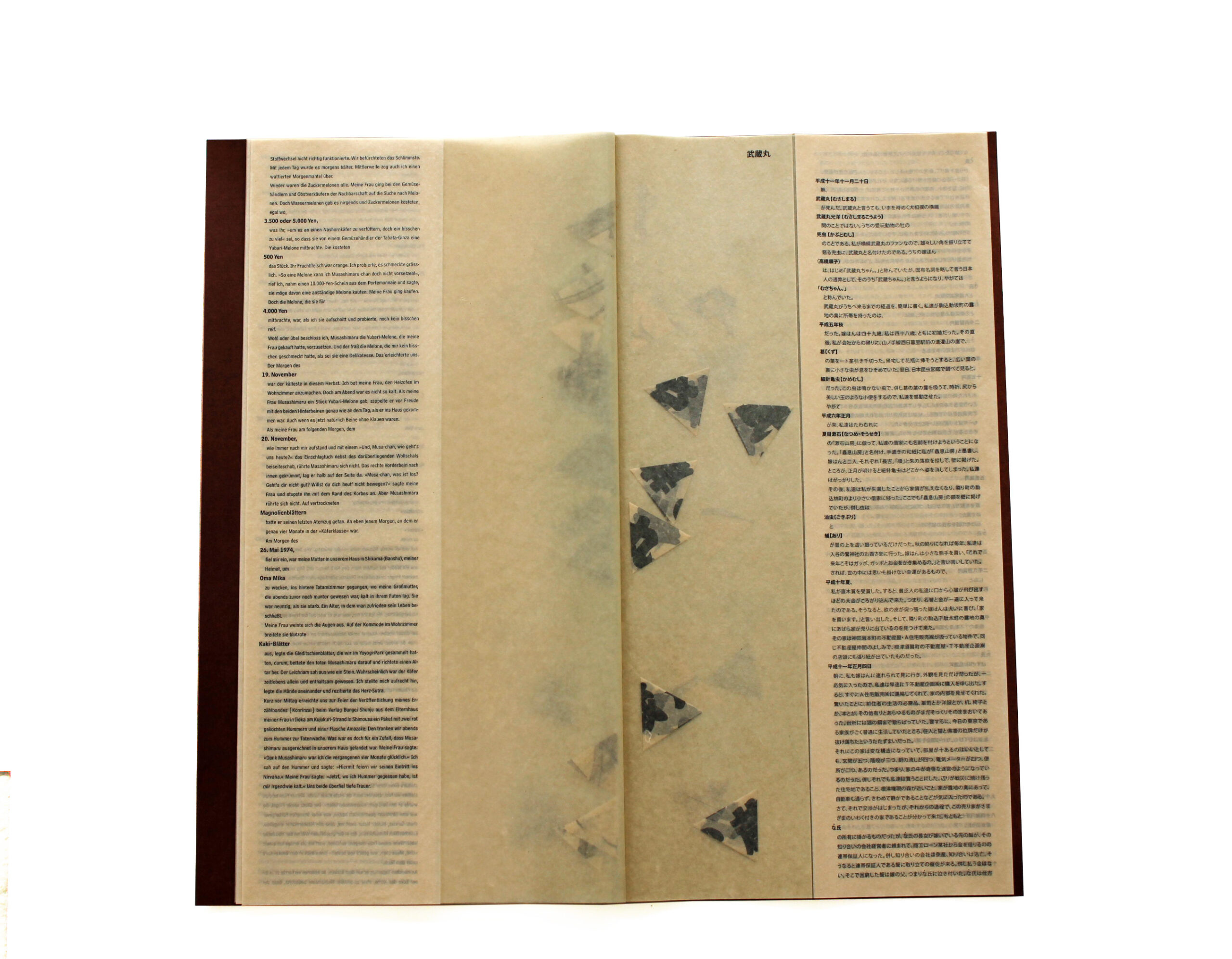Musashimaru
Musashimaru
Date
2013
Edition Size
40
Media
Hand-sewn, Letterpress, Silkscreen
Paper
Katagami, Mitsumata, toshaban genshi
Format
Artist Book
Dimensions
9 × 17 × 3.125 in
Pages
20
Location
Karlsruhe, Baden-Württemberg, Germany
Enclosure
Cedar box
$ 3,200.00
Unavailable
Choukitsu Kurumatani: Musashimaru
車谷長吉: 武蔵丸
The short story »Musashimaru« by the Japanese author Choukitsu Kurumatani is about a middle-aged couple who is keeping a rhinoceros beetle (oryctes nasicornis) as a pet for one summer and autumn.
Kurumatani wrote his story in the literary form of an »I-novel« (Jap. »shishousetsu«). This kind of Japanese contemporary literature is characterized by personal experiences and their preferably realistic descriptions, which are the source for fictional events. At the same time, the truthful presentation without any esthetical stylisation or ornamentation characterizes the » shishousetsu« as a form of the Japanese naturalism.
Kurumatani describes the everyday life of a couple – both are writers – who discover at a walk a rhinoceros beetle and decide to take it home as a pet. This is not uncommon in Japan, where in spring or early summer, a lot of kids look for larvae or just enclosed beetles, bring them home and hold them in small terrariums. The rhinoceros beetles live only for one summer; after mating or laying their eggs, they die in early autumn. The couple, however, tries everything to extend the beetle’s lifetime. They name it »Musashimaru« after a famous sumo wrestler and treat it like a close family member. They even hold a private funeral ceremony for him as one would do for a close relative, after he finally dies.
Kurumatani’s very detailed and objective way of writing goes to such lengths that he is listing all amounts of money he has to pay, or mentioning friends of the couple by name who are well-known in the Japanese literature scene. This gave me the idea to lay out the typography like an encyclopedia. The text is set in long columns in a narrow and small type, and characteristic terms like people’s names, amounts of money or botanical definitions, are highlighted in a bold font.
The prosaic and sober listing is emphasized by the structure of the book: every page consists of a folded page of text, with a printed column at the exterior edge. The opposite, interior egde contains a pocket with folded triangles that I used, because entomologists keep hunted insects in these satchets, before indexing them.
Three kinds of images are printed partly onto the pockets: a detailed illustration of a rhinoceros beetle by Hanna Zeckau, drawn especially for this book. Also a detail of a Japanese 1,000-Yen bill as well as a detail of an old sumo ranking list with the name of the Hawaian wrestler Musashimaru, who was one of the best wrestlers in the late 1990’s.
The pages as well as the small triangles consist of old and very thin ganpi paper, printed partly with tranparent medium. This makes the paper even more transparent and gives it an insect-like impression. It underlines at the same time the realistic and straightforward narration of the shishousetsu.
The book is bound into a cover of dark-brown wood-like paper. This katajigami paper which is dyed with persimmon juice, has not only the same color like old Japanese houses, but also reminds one of the color of a cigar. Therefore, it fits well into the cedar wood case in which the book is stored. This box is reminiscent of a cigar box in which specialists collect beetles and other insects. Not only because they are solid, but also because the scent of tobacco and cedar wood protects against pest infestation.
Choukitsu Kurumatani // Musashimaru from Veronika Schäpers on Vimeo.










